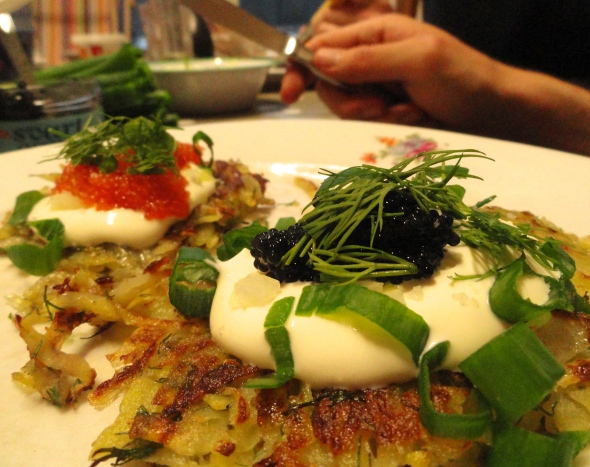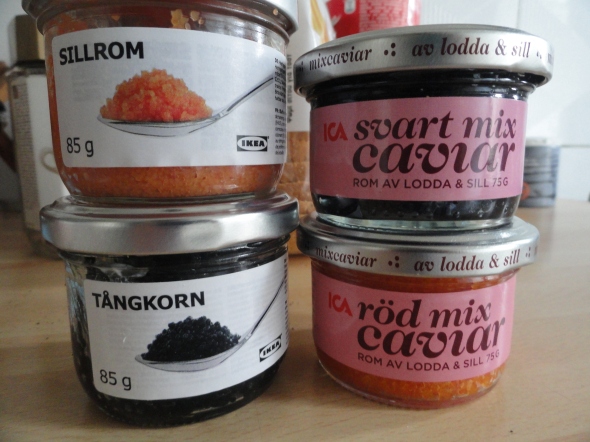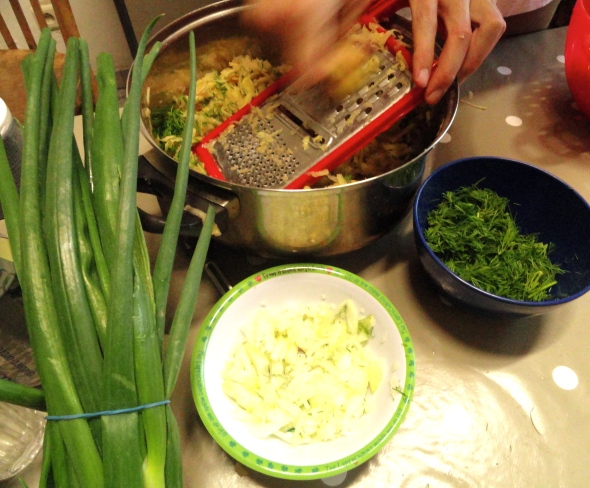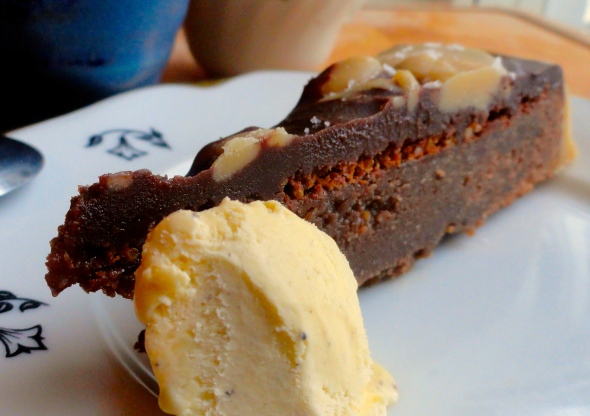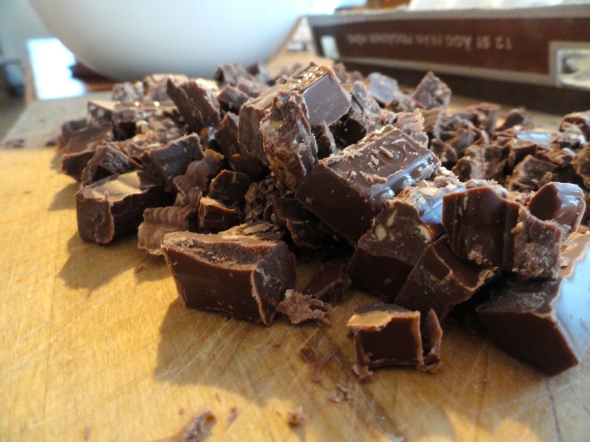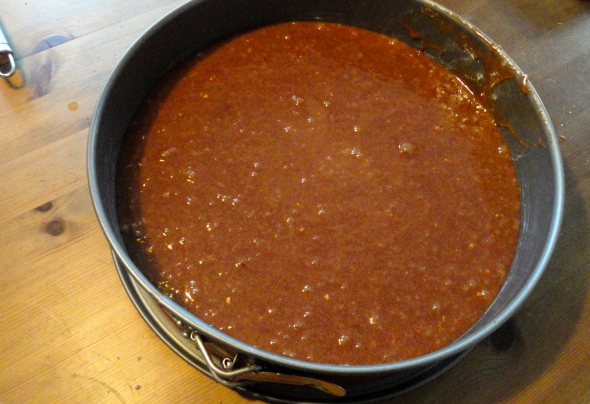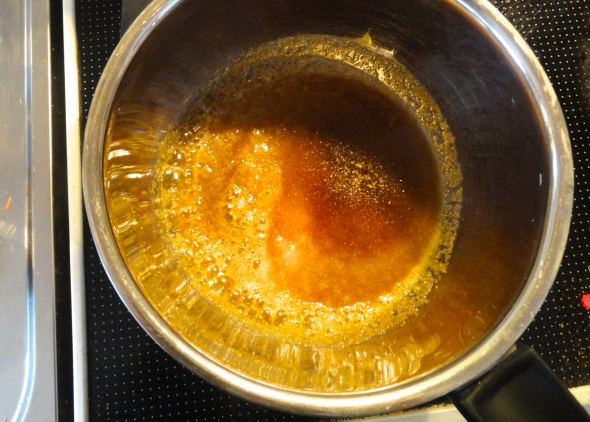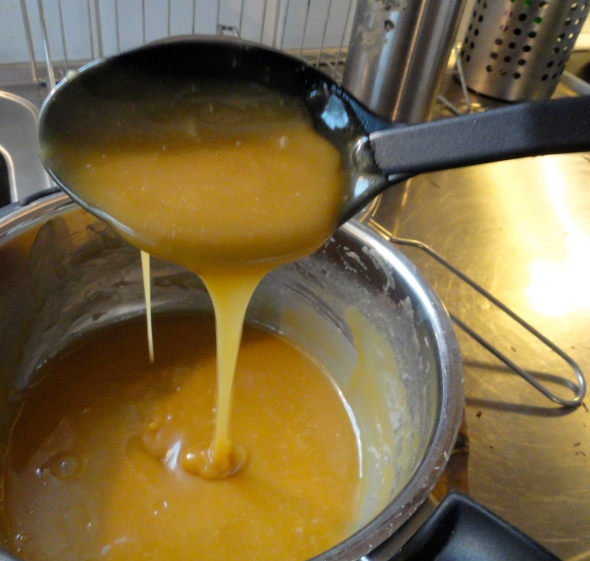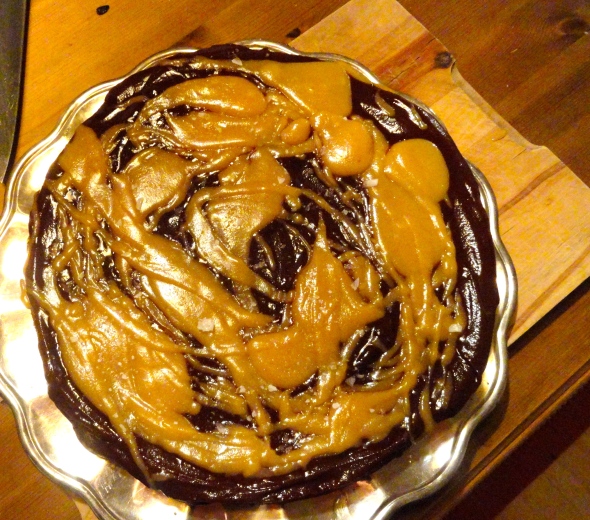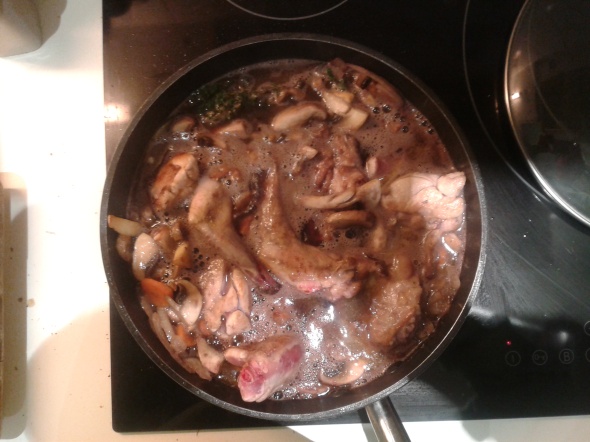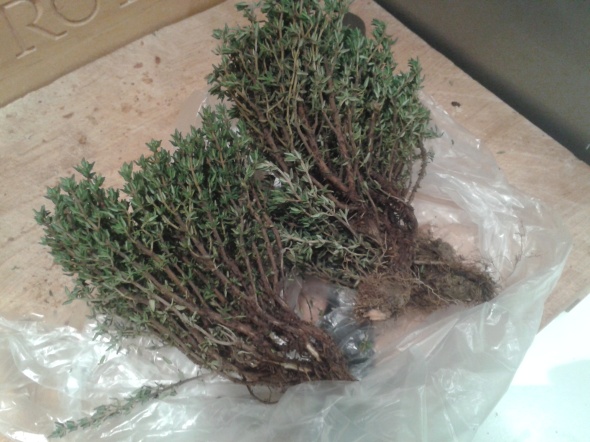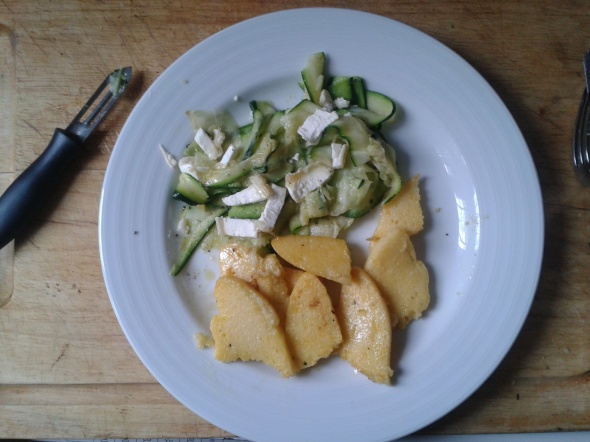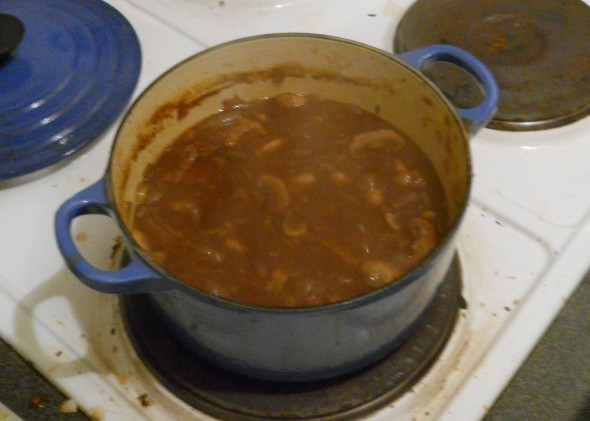Fried potato cakes with caviar (Rösti med kaviar)
Posted: May 18, 2013 Filed under: Recipes | Tags: caviar, cheap, dill, easy to make, husmanskost, potato, seafood, starter, Swedish Leave a commentWorking full-time leaves far too little time left over to cook. In my utopia we’d all be working three hours a day, followed by two hours food shopping at a cheaper version of Borough market, before cooking all afternoon and eating all evening. But before that’s been turned into a workable economic model, we have to make do with simpler things, like Swedish rösti with caviar. Quite a light supper, it’s a perfect snack before going out (don’t worry, that kebab in the wee hours of the morning will keep you from starving).
Making rösti is very easy, and you can take it quite far from its humble origins if you top it with fresh Swedish ingredients like gräddfil (sour cream), dill, spring onion and caviar. What with IKEA’s food empire being spread all over the world, you can buy Swedish caviar very cheaply. This isn’t fancy caviar in any sense (it comes from the herring), but it’s still salty and delicious.
You need:
- 1 tub of sour cream (creme fraiche also cuts it, but best of all would be gräddfil)
- Fresh dill, finely chopped
- Fresh spring onion or chives, chopped
- 1 onion, finely chopped
- 6 large potatoes, grated
- 1 egg
- A selection of caviar glasses – theses are about €1.50 in IKEA. They only have red, black and vegan caviar, so if you want nicer stuff find a Swedish shop where they will have Stenbitsrom or Kalixlöjrom.
Start by chopping and frying half of the onion on a low heat. Peel and grate the potatoes, and mix in the onion. Also add half of the dill, the egg and salt to taste. Form the mix into flat rounds, about half a centimeter thick, and carefully place in a non-stick pan, on a medium heat with plenty of oil and butter (a mix makes for the best flavour – it’s not meant to be a health meal). Flatten the cakes with a spatula once they are in the pan, as that makes them stick together better. Let them fry about 4 minutes on each side, until they are golden. Carefully lift them out of the pan onto kitchen roll, and keep frying these until you’ve used up all of the mix.
An easy way of eating them is to just place all the condiments on the table and let everyone make their own caviar creation. However, if you want it a bit nicer, place two rösti on each plate, add some of the chopped onion, a generous dollop of creme fraiche, the caviar of your choice, and top with chives, dill and spring onion. Serve with cold, light beer, and vodka if you are going out.
Rich chocolate and salted caramel cake
Posted: January 3, 2013 Filed under: Recipes | Tags: cake, chocolate, dessert, easy to make, salted caramel, sweet 4 CommentsI detest dry chocolate cake. The sugary sponge desserts found in some supermarkets or school canteens would put anyone off it for life. Yet chocolate mousse and elegant souffles are difficult to make, and often require lots of equipment. I found this recipe to be a perfect middle ground: it incorporates some of the stickiness of a Swedish kladdkaka, yet with all the richness of French chocolate creations. For all this, it’s still very easy to make.
The ingredient list is rather simple, although the golden rule with chocolate-based desserts mustn’t be forgotten: the better the chocolate in the base, the richer the cake. Having the luxury of living in Brussels, I brought several slabs of almost smoky dark, as well as milk chocolate with me home to Sweden this winter (or, they were a gift for my stepmother, but she didn’t mind them being used this way… at least not once she got to try the result). I used light and nutty milk chocolate for the cake itself, and a dark, almost bitter chocolate for the topping.
For the cake, you’ll need:
- 6 eggs
- 250 g unsalted butter
- 2,5 dl Sugar
- 60 g flour
- 250 g milk or dark chocolate, depending on taste
For the dark chocolate cover:
- 100 g unsalted butter
- 50 g honey
- 100 g dark chocolate
And for the salted caramel topping:
- 1/2 teaspoon sea salt flakes
- 1 dl Muscovado/brown sugar
- 100 ml double cream
- 50 g unsalted butter
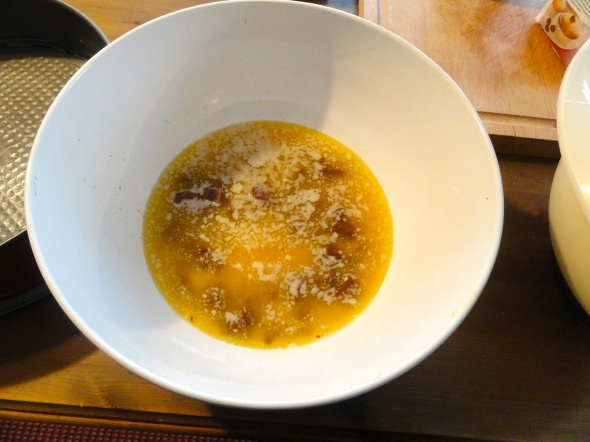 Starting with the cake ingredients, melt the butter, and mix it with the chocolate until the chocolate has melted entirely and you have a smooth mix. Put the oven to 200 degrees, and use some of the butter to grease the spring form tin.
Starting with the cake ingredients, melt the butter, and mix it with the chocolate until the chocolate has melted entirely and you have a smooth mix. Put the oven to 200 degrees, and use some of the butter to grease the spring form tin.
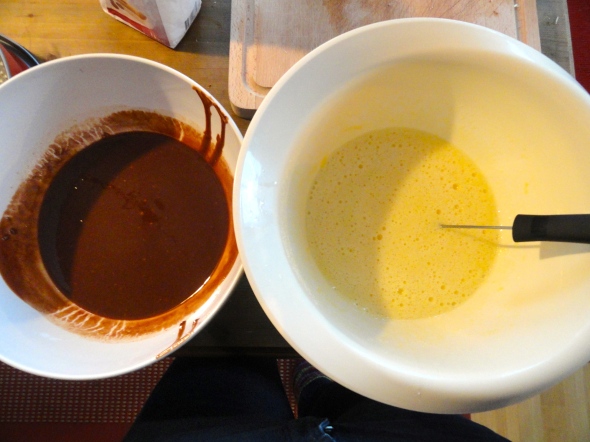 In a separate bowl, whisk the eggs and sugar until fluffy (you can use an electric whisk if needed), and then fold it into the chocolate-butter mixture.
In a separate bowl, whisk the eggs and sugar until fluffy (you can use an electric whisk if needed), and then fold it into the chocolate-butter mixture.
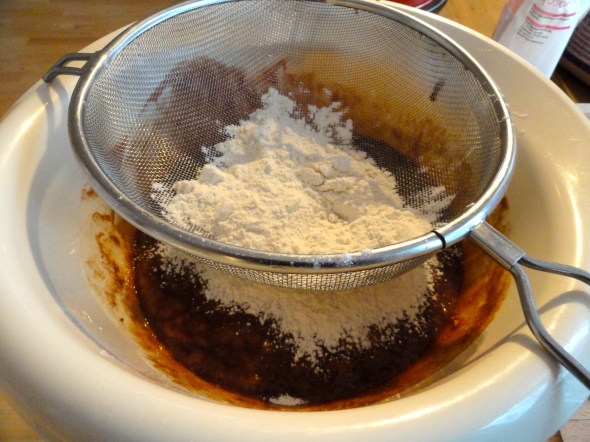 Finish making the base for the chocolate cake by sifting the flour into the chocolate mixture, folding it carefully so not to lose the fluffiness.
Finish making the base for the chocolate cake by sifting the flour into the chocolate mixture, folding it carefully so not to lose the fluffiness.
Pour the mixture into the spring form, and bake in the oven at 200 degrees for about 30 minutes, but be careful not to overbake it. The cake should have just started to settle when you take it out, and sway lightly if you move the tin around. Leave it to cool uncovered. Once it has cooled to room temperature, put it into the freezer for a couple of hours, but remember to remove it from the freezer at least two hours before you plan on serving it.
When the cake is in the freezer, you can start making the chocolate topping, which is pretty easy: melt the butter and pour it into the dark chocolate, and mix around until you have a smooth cream. Add the honey into the mix, and put to the side to cool.
Then start making the salted caramel.
Melt the muscovado sugar in a dash of water on the stove. Be careful: just swirl it with large sweeps of the pan, and don’t use any tools in the pan with the sugar. Add the butter, and let it melt, again just swirling the pan. Once the butter has melted, add the cream, and let it bubble away for 5 minutes until it has thickened slightly. It will thicken more once it cools down, so you don’t want to thin it down too much. Finish by adding half a teaspoon of sea salt into it. Put to the side to cool.
Just before serving, spread the dark chocolate sauce evenly across the cake. Then add the caramel in long streaks across the cake, spreading it as elegantly as you can (as you can see below, artistry is not my strong side). Top off with a small dusting of sea salt flakes. Serve with whipped cream or vanilla ice cream. It will be dark, creamy and deliciously over-the-top, with a perfectly balanced saltiness in the topping.
Red Wine And Rabbit Stew With Polenta, And Leftovers
Posted: November 13, 2012 Filed under: Eating Paris, Recipes | Tags: comfort food, easy to make, French, goats cheese, mushrooms, polenta, rabbit, stew, wine 2 CommentsI know rabbit might not be for everyone, and many of you will be thinking of this:
And not of this:
But I can assure you that rabbit meat is delicious… a bit like chicken (looks exactly like it…) but gamier. I recently spent a week at my parents’ house in Paris where rabbit meat is as common as chicken’s and was presented with two rabbits to cook for dinner. I had never cooked it and did not have many ingredients so decided to go for something I know how to do well: a wine stew. I mean you can never go wrong with wine and meat… add some butter and it’s heaven!
For this recipe you will need (enough for five people)
– Two rabbits cut in smallish pieces (ask your butcher to do it, it’s usually in six pieces)
– Two carrots, minced.
– An onion, chopped.
– 300 grams of mushrooms, roughly chopped (preferably a mix of nutty mushrooms).
– Two bunches of thyme.
– Half a bottle of wine (pour the rest into a glass and drink it to get over the fact you’re eating a cute bunny).
– A lot of butter
Start by adding a knob of butter to a pan and brown the rabbit pieces. Reserve and do the same with the mushrooms in batches so they brown but don’t become mushy. Put them aside with the rabbit and add more butter to the pan. Add the onion and carrots and sweat them for 5-10 minutes. When they become soft, turn up the heat and add the wine and the thyme. You can also add a bay leaf at this point.
Let the wine reduce to half and then add the rabbit and the mushrooms. Make sure they are covered and add water if needed. Season with salt and pepper and let cook for at least 45 minutes on very low heat, with a lid on. When the meat looks like it’s cooked and almost falling off the bone take the lid off to let it reduce. Right now is the time to prepare the polenta. If you are experienced you can have a go at polenta flour which has too cook for 45 minutes with constant turning and gives you an arm ache and possibly some burns. If you are not an experienced Italian grandma, grab a good quality semi-ready polenta and follow the instructions. When the polenta is almost cooked add some cream or ricotta cheese and some parmesan. Season with salt and pepper and serve the stew over it.
The next day, if you are lucky to have some stew and polenta left, serve them together. If like me all you had is polenta, fry it in a pan with some butter until it’s crispy. For the courgette, slice it really thinly (with a peeler or a mandolin) fry it for 2-3 minutes in some butter and sprinkle it with salt, pepper, good olive oil and goat’s cheese. And there you go: a really easy and healthy second meal after the indulgence of rabbit and wine.
(Sorry for the low quality pictures, I only had my phone)
Peppe’s courgette and parmigiano soup
Posted: November 2, 2012 Filed under: Recipes | Tags: cheap, courgette, easy to make, Italian, parmigiano, soup, veggie Leave a commentI live with a dramatic Sicilian, and predictably, everything he touches turns into kitchen gold. I’ve stopped taking pride in my home cooking, as everything I make pales in comparison to the humble little dishes Peppe throws together. My favourite soup of his so far is very simple: it has courgettes, potato, onion and garlic. The secret is that it is thickened and made savoury with parmigiano, and has tons of aroma thanks to Peppe’s mother’s own olive oil.
I’m somewhat of an olive oil skeptic, as I feel it’s being used and abused all the time where it doesn’t quite belong. You need look no longer than Jamie Oliver for examples of that, and to illustrate my point I’ll just point you to this hilarious, simple montage from his shows. However, if strong olive oil belongs anywhere surely it is in Sicilian cooking. Of course, sourcing home-made Italian olive oil might be near impossible, but as long as you invest in a very good quality bottle, you should be on the right way. And spending a bit on the parmigiano and olive oil is worth it: coming home to this after a long night at the office and a damp walk home in uncomfortable shoes feels like the most wholesome experience ever.
You need:
- 3 large potatoes
- 3 courgettes
- 2 yellow onions
- 1 garlic clove
- half a cube of vegetable stock
- Good quality olive oil
- Grated parmigiano
- Water
- A blender to blitz the soup in the end
Start by slicing the onions, and then fry them with a generous splash of olive oil in a deep-bottomed pan. Add the whole, peeled garlic clove after a few minutes, and fry on medium heat whilst you peel and chop the potatoes, and chop the courgettes (keep the peel on). Add the courgettes and potatoes together with the stock cube, and add just enough water to make sure everything is covered. Boil for about 20 minutes or until all the vegetables have softened considerably, then take off the heat and spoon out a little bit more than a coffee mug’s worth of water (you can save and freeze this as stock to use on some other occasion). Take to the side and blitz with a blender for about a minute, or until you have a smooth, rather thick soup. Add salt and pepper to taste. When done, serve in bowls with a generous sprinkle of parmigiano and a few additional drops of olive oil, as well as some crusty bread.
Nigella’s apple & almond cake
Posted: April 15, 2012 Filed under: Recipes | Tags: almond, apple, baking, cake, easy to make, gluten-free, Nigella 5 CommentsThis cakes really melts in your mouth, because it contains no flour. It contains no flour because it is Nigella’s cake for passover. However, flourless, eggless and yeastless as it is, it is absolutely delicious and therefore you should make it. Imagine a dense, slightly coarse mousse made out of tart apple and ground almonds. This looks like a cake but in fact it tastes very little like one, and therefore I love it (because most of the time I don’t really like cake). It should be noted that this is the kind of cake I make when someone else is paying for the ingredients: almond flour is expensive (but so incredibly flavoursome and lush to bake with) and 8 eggs for one cake may seem a bit frivolous (although as a southern Swede I feel some affinity with this*). But it’s a winner for special occasions (or if you need to make cake for a gluten-allergic, with different frosting it could definitely pass for a posh birthday cake). You will need the following ingredients:
- 376 g almond flour
- 250 g sugar
- 8 eggs (!)
- 3 apples
- 1 lemon
- Flaked almonds
- Pearl sugar (optional; Swedish topping as described in this post)
- Plus a spring form, baking paper and a food processor/mixer for making it. Lacking this it might be difficult to make. Although perhaps one can experiment with muffins tins and stuff.
Start by melting the apples together with the sugar and some lemon juice on the stove. While they are bubbling away, mix all your other ingredients (apart form the pearl sugar and flaked almonds) in the food processor (if you, like me, only have a mixer, you can pre-mix the stuff in another bowl and the blitz as much as you can get into the mixed bit by bit). The apples should be a bit cooled down lest they start cooking the eggs prematurely, so after they’ve softened ont he stove for ten minutes you may want to create a makeshift cold water bath int he sink to speed up their cooling process before you mix them with the rest.
Once you’ve blitzed all your ingredients and put them in the cake tin (greased and lined of course), put it in the over at 180 degrees for about 45 minutes. The result will be a bit gooey and wet, but it’s meant to be. Nigella says to eat it whilst it is stilla little bit warm, but I actually preferred it two days old. It’s so juicy the concept of “stale” goes nowhere near it.
* Swedophiles may be interested to learn that old southern Swedish cooking usually involved obscene amounts of eggs. Partly this was the result of an attempt to distinguish southern cuisine as rich in eggs, cream, and butter from that of the starving North, and particular the bastard Stockholmers. (The Treaty of Roskilde making Skåne Swedish was signed in 1658, but not everyone is over it yet).
Puttanesca
Posted: February 23, 2012 Filed under: Recipes | Tags: anchovies, capers, easy to make, Italian, olives, pasta, tomato sauce Leave a commentPuttanesca is a loaded name for a fiery pasta dish (Meatball and Salted Cod reject imposing stigmas on innocent pasta so won’t develop it more here. But there’s always google…). It is garlicky and rich with anchovies and tomato and has a fiery kick of chili, which blends with saltiness from olives and capers. It was supposedly invented in Naples or Syracuse, and I’ve been told it is good with tuna. In any case it is delicious as it is, makes your kitchen smell like an Italian restaurant and requires very few ingredients (if you substitute the fresh chillies with dry crushed ones it doesn’t require anything fresh, so it’s a good SOS-dish when you’ve got very little at home but all the stores are closed/too far away/it’s raining/can’t afford a take-away/all the local take-aways are overpriced rubbish/don’t fancy another night with packet noodles). In short, it’s a winner. Did we mention it is cheap? It is also super-simple to make, so another recipe for the kitchen-phobes out there.
For 2 persons:
- 4 heaped tablespoons of olives, roughly chopped (preferably greek calamata but cheaper stuff works too)
- 2 tablespoons capers (more if you like it salty, less if you want it milder)
- 1 can peeled plum tomatoes (chopped tomates are also good, but the peeled taste tomatoier)
- 3 cloves garlic
- 4 anchovies
- 2 red chillies (or chili flakes to the strength you fancy)
- Spaghetti or linguine
Start with slicing the garlic cloves thinly, and de-seed and chop your chillies. Fry this together with the anchovies in some oil for a few minutes until their flavours are released and the anchovies dissolve (it smells amazing together) and then add the can of peeled plum tomatoes. Make it simmer, then turn down the heat. Crush the tomatoes with a suitable utensil. After 10 minutes, start making your pasta. When the pasta is almost done, put the tablespoons of olives and capers into the sauce and let them heat up. Drain the pasta and mix it in with the sauce. Done!
(If you are into your cooking programmes, Meatball and Salted cod can strongly recommend the BBC French food fetishism that is Raymond Blanc: The Very Hungry Frenchman; it goes as well with a large plate of puttanesca as a full-bodied bottle of Primitivo).
Saucisses de Toulouse aux Lentilles du Puy – French Sausage Casserole
Posted: February 17, 2012 Filed under: Recipes | Tags: comfort food, easy to make, French, lentils, sausage 2 Comments
Last week I went home to visit my parents who, surprisingly, do not live in the land of salted cod, but in Paris! Every visit home is a chance to indulge in all the amazing food and ingredients Paris has to offer (I will soon be doing a mini-guide to Paris).
Among many meals this one stood out, especially as it is a French classic. It can obviously be made outside of France as most of the ingredients are easily available (you can substitute Toulouse sausages for Cumberland sausages or use normal green lentils instead of Puy lentils). This is my version of Saucisses de Toulouse aux Lentilles du Puy, which might be slightly different from the classic recipe.
You will need (for six):
- 1 large onion, finely chopped.
- 1 large carrot, finely chopped.
- Half a Spanish or Portuguese chorizo, sliced roughly.
- 1,5 kg of Toulouse (if you can find it) sausage meat, cut in pieces.
- 650 g of Puy Lentils, rinsed (or other green lentils).
- Some rosemary sprigs.
- A glass of red wine.
- Half a litre of beef stock.
- Salt and Pepper.
1. Start by browning the meat in some olive oil. When all sides are brown, remove from the pan and reserve.
2. Using the same pan fry chorizo for a few minutes on a medium heat and then add the onion and carrot. When the vegetables become soft, add the garlic and fry for a further 2 minutes.
3. Turn the heat up, add the wine and let the alcohol evaporate.
4. Turn the heat down, add the sausages, the lentils and the rosemary and mix well. Add the stock (adding enough more water, if needed, to cover everything.
5. Season with salt and pepper, cover and cook for 25 minutes.
Enjoy
Blue cheese fettuccine with leek and walnuts
Posted: February 9, 2012 Filed under: Recipes | Tags: artichokes, blue cheese, easy to make, pasta, quick, veggie, walnuts 4 Comments- 1 pack St. Agur blue cheese. Experimenting with other, cheaper blue cheeses is probably a good idea, however I’ve tried making this with english stilton and that was way too bitter.
- 1/2 leek
- Fettuccine (or any pasta you prefer, but the sauce works well with long, slingery things)
- Half tub of creme fraiche
- A few generous handfuls of walnut kernels
- Spinach (optional)
- 1 can of artichoke hearts in water, roughly chopped (optional)
- Butter for frying
Mushroom Bourguignon
Posted: February 8, 2012 Filed under: Recipes | Tags: cheap, comfort food, easy to make, mushrooms, rich, stew Leave a commentWhen it’s freezing outside and you’re missing homely comfort food, there is nothing better than a stew. Although I would love to be able to cook and eat a boeuf bourguignon almost everyday, there just is no time for a five hour stew during the week. So I bring you an adaptation of the boeuf bourguignon, the equally decadent mushroom bourguignon.
Altough the main ingredient (beef) changes, the other ingredients and method remain the same (bar the five hour cooking time!). This makes a very cheap and easy to make mid-week bourguignon.
So you will need:
- Onion, finely chopped (one per 2 person portion).
- Carrot, finely chopped (1/2 per 2 person portion).
- Mushroom, with no stems and chopped roughly (500 grams per 2 person portion).
- Garlic, finely chopped (to taste)
- Beef stock (or vegetable stock if you are a vegetarian…)
- Tomato Paste (1 tablespoon per 2 person portion)
- Red Wine
- Olive Oil
- Lots of butter!
- Thyme (dried is fine)
- Small cooking onions, or pearl onions if you can find them (optional)
- Some flour (not self-raising)
- A sturdy pan
1. Start by chopping the mushrooms and frying them in your pan in butter and olive oil on a high heat so that they brown. While they are cooking chop the carrot, onion and garlic.
2. When the mushrooms are browned, take them from the pan and reserve. Turn the heat down to medium, add some olive oil to the pan and fry the onions, carrots and thyme, adding some salt and pepper to season. When the onion starts to brown add the garlic and fry for a further 2-3 minutes, stirring constantly so the garlic does not burn.
3. Turn the heat to high, add the wine and let it cook until it’s been reduced to half its original size.
4. Turn the heat down to a low setting, add the tomato paste, the stock and the mushrooms with the juice they have released from cooking (and the small onions, if using). Bring to the boil and then simmer until the mushrooms are tender.
5. While the stew is simmering start making a roux (it sounds harder than it is) and stir it in the stew when the mushrooms feel tender but the sauce is still a bit liquid. Simmer for a further 5 minutes to thicken the sauce and check the seasoning.
Serve it over your favourite carbs. We had it over pasta, but it’s great over polenta or mash. Add a little bit of butter for extra amazingness.
Swedish bacon pancake (Fläskpannkaka)
Posted: February 2, 2012 Filed under: Recipes | Tags: bacon, cheap, comfort food, easy to make, husmanskost, pancake, Swedish 3 CommentsLondon is freezing at the moment. If you, like me, are living in a chilly, damp, poorly insulated house, this recipe is a good excuse to use the oven as a heater for a little while (as well as adding badly needed heating, leaving the oven open afterwards makes the house smell of bacon pancakes! And that can never be a bad thing.). Described as “Swedish comfort food” by Mr Meatball who I made it for yesterday, it needs very little work and few ingredients, so it is perfect for someone lazy, living off meagre student finances with an empty fridge. Rumour also has it Swedish air stewardesses make this a lot.
For two hungry persons, you need
- 3 eggs
- one pack of bacon or some other kind of smoked porky meat (400 grams)
- 2 deciliters flour
- 4 deciliters milk
- Salt (all Swedish cooking demands lots of salt. So think lavishly and salt with your heart)
- (Optional yet crucial) Lingonberry jam*
Put your oven to 225 degrees. Cut the bacon strips into smaller bits a wide, shallow oven pan. This is easily done with scissors. Put the pan into the oven and let the bacon pre-fry until it looks like the first picture in the slideshow, for about 10 minutes. Whilst that is in the oven, mix the flour and salt, and whisk in the milk slowly until you have an even mix. Crack in the eggs, whisk, and pour this on top of the bacon in the pan. I cut som parsley into it too but mainly to make it look pretty. Put the pan into the oven for 25-30 minutes until it has gone golden, and risen considerably. Once you take it out it will collapse upon itself. It should be a mellow brown in the edges, but gooey and yellow on the middle and inside. Cut into large slabs and eat with copious amounts of lingonberry jam. Enjoy!
* This is a sour, red jam, which like salt, comes in excessive amounts with most things considered Swedish traditional food. You can pick some up at your nearest IKEA, or if you’re in central London, get some here. Or you can supplement this with Cranberry sauce, but that woud be a shame.
